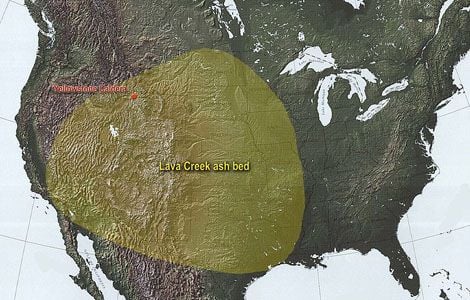Taking the Measure of Yellowstone’s Supervolcano
Still a threat, but don’t cancel your vacation just yet.
Despite all the attention given in recent years to the threat of asteroid impact, it appears that many extinction events in Earth’s history were related to the eruption of so-called "supervolcanoes"—eruptions thousands of times stronger than a typical volcanic outburst, with a volume of ejected lava and ash of 1,000 cubic kilometers or more. Relics of these powerful blasts can be seen in the Deccan Traps in India, the Siberian Traps and the Columbia Plateau in the U.S. Pacific Northwest.
Scientists have long known that a potential supervolcano eruption is looming in Yellowstone, where some 200 to 600 cubic kilometers of molten rock lies in a magma chamber underneath the National Park. Yellowstone has erupted violently three times in recent geological history: 2.1 million years ago, 1.3 million years ago, and 640,000 years ago. A new eruption cannot be ruled out. The last time the Yellowstone volcano blew up, more than 1,000 cubic kilometers of ash and lava were ejected, affecting a large part of North America. Obviously, an eruption on this scale would have global climatic consequences. Just think about the Lake Toba supervolcano eruption, which by some accounts brought the human species to the brink of extinction.

How likely are these eruptions? In a book that I co-authored in 2012 with David Darling, we gave supervolcanoes a rating of 4 on our "catastrophe meter" scale from 0 to 10, meaning that the events are extremely rare, but are global killers when they do occur. Now a new study calls into question whether they really are as rare as we thought.
Writing in the journal Nature Geoscience, Carmen Sanchez-Valle and co-authors say that supervolcano eruptions don't necessarily need an external trigger such as a nearby earthquake, but can occur just because of internal density differences. The researchers used a powerful new x-ray instrument that was able to take accurate density readings up to temperatures of about 1,700 degrees C and pressures of up to 36,000 bar (one bar is Earth's atmospheric pressure). Sanchez-Valle and co-authors showed that the magma chamber underneath Yellowstone is big enough that overpressure by differences in density is strong enough to burst through the overlying crust.
The good news is that an eruption based on internal density differences doesn't seem to be imminent—and the needed build-up would take tens of years at the minimum. Also, based on modeling of supervolcanoes by Luca Caricchi and co-authors, the eruptions due to overpressure are typically relatively small and frequent—not the kind that causes global catastrophe. So if you've planned a camping trip to Yellowstone next summer, you can sleep in peace.
/https://tf-cmsv2-smithsonianmag-media.s3.amazonaws.com/accounts/headshot/Dirk-Schulze-Makuch-headshot.jpg)
/https://tf-cmsv2-smithsonianmag-media.s3.amazonaws.com/accounts/headshot/Dirk-Schulze-Makuch-headshot.jpg)